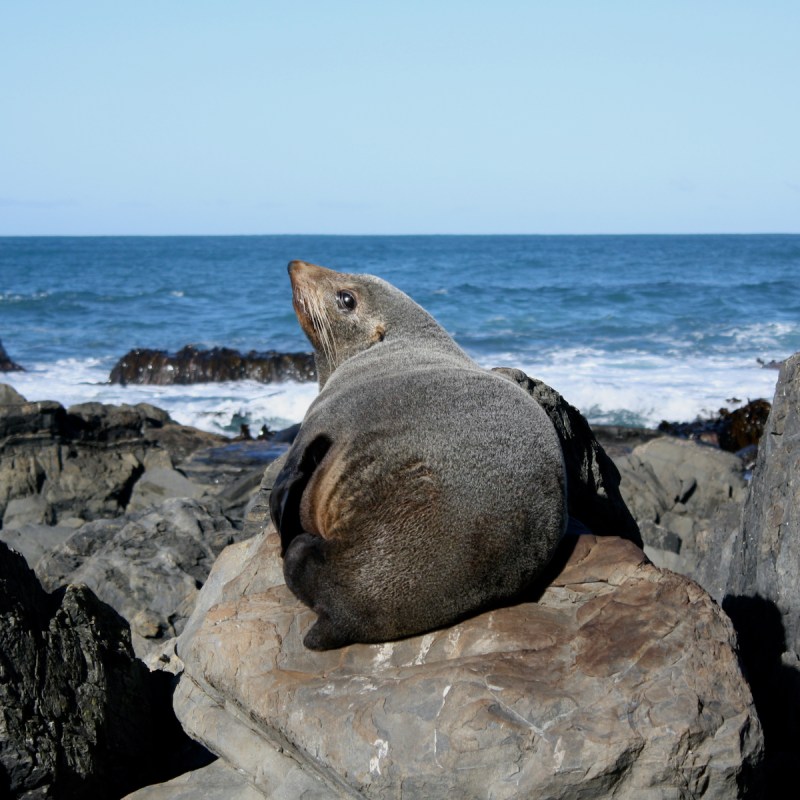
Tree-covered hills and the sea surround Wellington, New Zealand’s capital city. With nature so close by, there are many opportunities to see New Zealand’s native wildlife. New Zealand is famous for rare flightless birds including the national icon, the kiwi, while more common species such as the tūi and kererū fly around the city. There’s other wildlife too — marine mammals, lizards, and even insects.
Videos by TravelAwaits
Many visitors take the ferry between the North Island and the South Island and pass through Wellington, so it’s worth allowing some time to explore. Some places where you can see wildlife are so close to the city that they are a short car or public transport trip away and don’t require serious hiking. Here are three places in Wellington that are great for spotting different species of wildlife and are easy to get to.

Zealandia
An Urban Ecosanctuary
When the only sounds are rustling leaves and bird calls, it’s hard to believe Zealandia is surrounded by suburbia. This ecosanctuary was created by building a predator-proof fence around a former water supply dam and gradually reintroducing native species of birds and plants. Today, Zealandia is home to more than 40 species of birds that have flourished and even spread beyond the sanctuary’s boundaries.
Kākā
It’s an easy walk along the main path from the entrance to the forested area where the distinctive orange feathers of the kākā swoop overhead. Kākā are an endangered species, but their numbers have increased in Zealandia, and they are sometimes even seen in city parks. When I visit Zealandia, I wait by the bird feeders at feeding time and always see kākā flying in to feed there.
Takahē
Down the hill, a pair of takahē forage in the grass in the wetland area. The flightless takahē was thought to be extinct until scientists rediscovered it in a remote mountain area in 1948. The population now totals about 440 because of conservation efforts in Zealandia and elsewhere.
Tuatara
As well as birds, Zealandia has various reptiles, including the tuatara, a rare species that is a surviving relic from the age of the dinosaurs. Tuatara live in burrows and emerge to bask in the sun, so they can be hard to spot. The area they inhabit is signposted and Zealandia volunteers will point out any tuatara that are visible. I often see skinks and geckos darting across the track or lurking under leaves at the side of the track where they are well-camouflaged.
Back at the entrance, an exhibit gives background on the wildlife in the sanctuary. I find the photos and sound recordings of bird calls help to identify any unfamiliar birds. There’s a café there too, although it’s nice to picnic outside by the lake on a fine day.
Getting to Zealandia is easy via shuttle or public bus. It’s a few minute’s drive from the central city and has parking for cars and campervans.
Pro Tip: Zealandia runs several guided tours that help visitors spot birds and learn to identify birds that you might see around the city. The best is the night tour where there is a high chance of seeing kiwi foraging in their natural nocturnal habitat.

Matiu/Somes Island
A Scientific Reserve In Wellington Harbor
On board the ferry to Matiu/Somes Island, we were lucky to spot penguins swimming in the water. It’s worth keeping an eye on the water, as dolphins are fairly common in Wellington Harbor, and orcas are occasional visitors.
After a steep uphill walk from the wharf, I took the path to the lighthouse. This path overlooks cliffs, rocky islets, and gives the best view for birdwatchers. Seabirds flew around, searching for food and returning to their nests. I recognized southern black-backed gulls and variable oystercatchers, whose long orange beaks made them instantly visible.
Like Zealandia, Matiu/Somes Island has tuatara that were introduced as part of a national breeding program. It’s more difficult to spot them here than in Zealandia. However, I saw plenty of skinks and geckos along the paths, mostly basking in the sun.
Wētā
Another inhabitant of the island is the wētā. While these insects tend to be nocturnal, there is a “wētā hotel” near the lighthouse — a hollowed-out log with a shutter that I opened to see a rather large wētā inside.
Returning to the wharf, I walked along the small section of the shore open to visitors. It was nesting season and, taking care not to get too close, I spotted several birds sitting on their nests. Access to most of the shoreline is restricted to protect the birds.
The ferry leaves from Queens Wharf in central Wellington and takes half an hour to reach the island. How long to stay on the island depends on ferry timetables, with a minimum 2-hour visit. A longer visit allows time to explore the quarantine station and admire the view of Wellington from the top of the island.
Pro Tip: If you want to picnic while you’re on Matiu/Somes Island, bring food and water with you, as there are no shops or cafés there. It also has no garbage disposal facilities, so visitors are asked to take any garbage with them when they leave.

Red Rocks Coastal Walk
New Zealand Fur Seals
The Red Rocks Coastal Walk along Wellington’s rugged southern coast leads to a seal colony. Although it takes an hour to get to the colony, there are spectacular views of the South Island along the way. On a clear day, snow is visible on the peaks of the Kaikōura Ranges. The gravel road winds beneath high cliffs, past the rust-red rock formations the walk is named after. Finally seals start to appear, sunning themselves on rocks, and then around a bend, large numbers of seals are lying around.
These are New Zealand fur seals and while they tolerate their numerous visitors, it’s best to be careful around them. Signs at the reserve advise keeping 20 meters away and not getting between the seal and the sea. I’ve also found that seals are well-camouflaged and can look very much like a rock when they are asleep, so I watch where I step. Seals have a pungent smell, another reason not to get too close.
The seals spend a lot of time sleeping, and occasionally yawn, stretch, and rollover. When they wake up, they often head for the sea and dive in. The colony has seals of all ages, from very young to weatherbeaten old seals. Occasionally a fight breaks out between male seals over territory, but otherwise, they are fairly quiet.
It’s easy to spend an hour observing the seals and their behavior, so allow 3 hours overall to walk there and back to see the seals. After the walk, if you would like a coffee, the nearest cafés are at Island Bay. I like the Beach House and Kiosk. It has great coastal views and I often see divers exploring the marine reserve offshore or ferries sailing to the South Island. While taking water and snacks on the walk is recommended, there’s not really a good place to picnic along the way.
Driving is the easiest way to get there and there is a car park at the entrance. The road into the reserve is accessible to 4WD vehicles only. Although it is possible to get close to the entrance by public bus, this requires changing buses.
Pro Tip: The best time to visit Red Rocks is between April and September when the seals migrate north from sub-Antarctic islands in search of warmer weather. While the seals find the weather warm, it is autumn and winter in Wellington which can be cold, so wearing warm clothing is recommended. The walk is exposed to southerly winds and it’s worth checking the weather forecast before setting out.
For more information on traveling to New Zealand, check out these articles:
